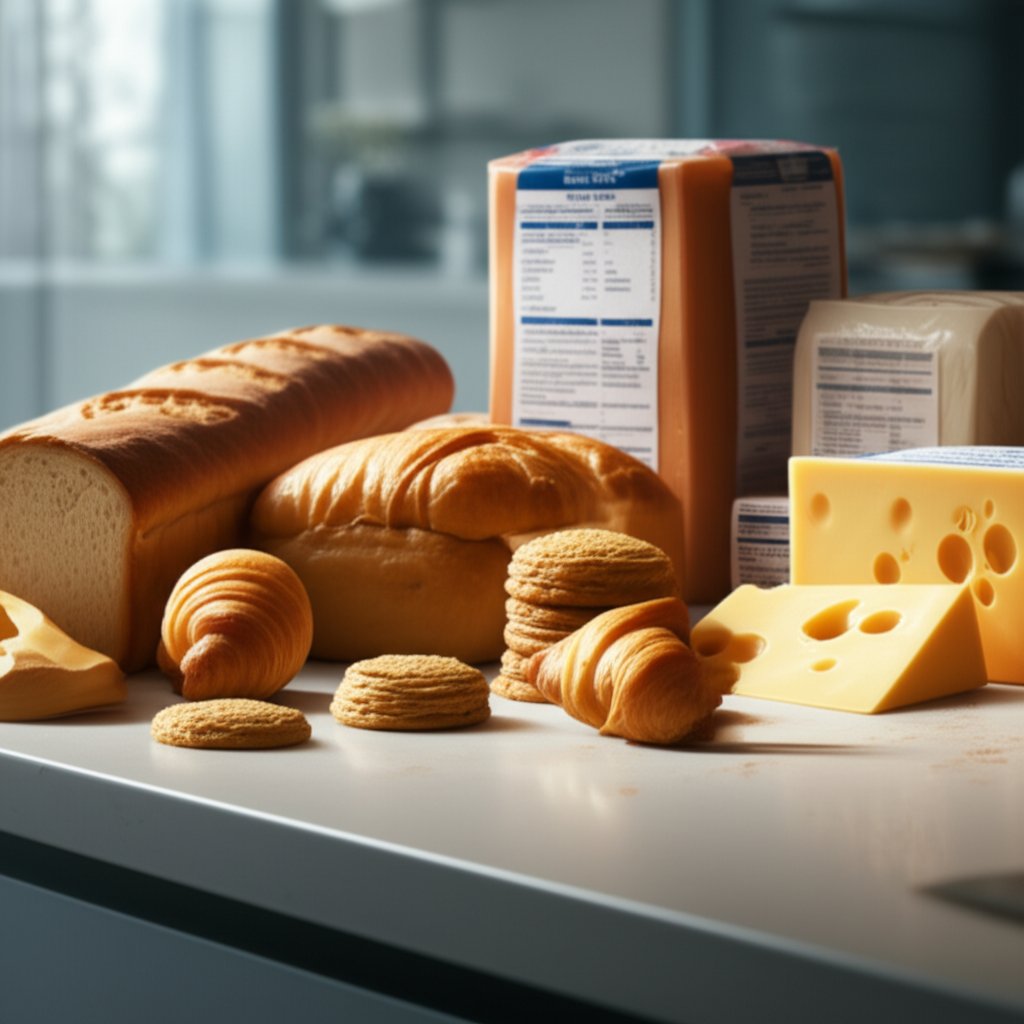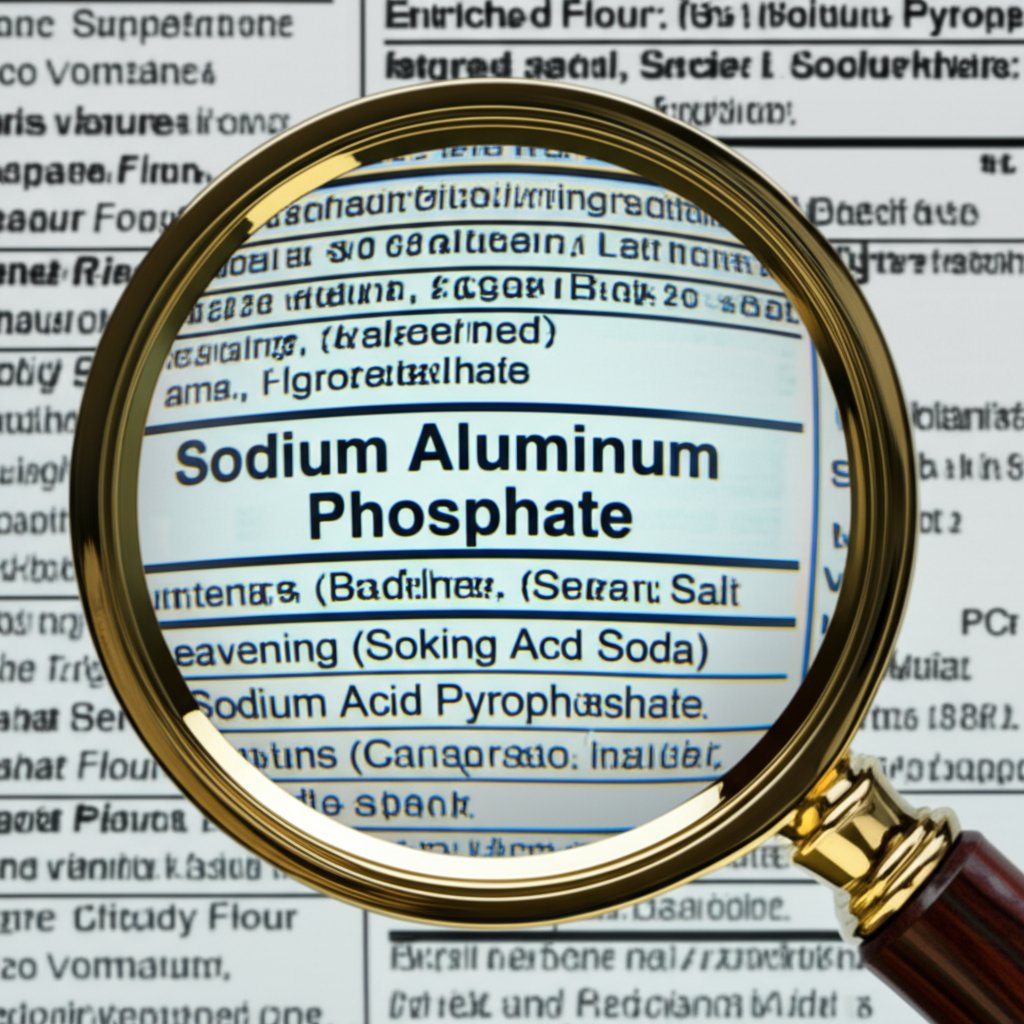
Ever wondered what’s behind the label “E541” on your favorite baked goods or processed cheese? If so, you’re not alone. Many consumers are curious about sodium aluminum phosphate—often abbreviated as SAP or SAlP—and its role in the food industry. Let’s break down what is sodium aluminum phosphate, why it’s used, and what makes it unique among food additives.
SAP is a family of inorganic compounds, technically known as sodium salts of aluminum phosphates. Sounds complex? Imagine SAP as a group of related substances made by combining sodium, aluminum, and phosphate ions. The most common form you’ll see in food is labeled as E541 in Europe. The sodium aluminum phosphate chemical formula can vary, but a widely used version is NaH14Al3(PO4)8·4H2O. This means each molecule contains sodium (Na), aluminum (Al), phosphate groups (PO4), hydrogen (H), and water (H2O) molecules.
When you see the phrase “chemical formula for sodium aluminum phosphate,” it’s referring to these specific arrangements of the elements. The formula can look intimidating, but it simply reflects the ratios of sodium, aluminum, and phosphate in the compound. For example, the basic form may be written as Na3H15Al2(PO4)8, while the acidic form is NaH14Al3(PO4)8·4H2O[source].
Not all SAP is created equal. There are two main types:
Understanding the distinction between acidic and basic SAP is key to grasping its many uses in food. Both types are produced through a chemical synthesis involving sodium carbonate, aluminum hydroxide, and orthophosphoric acid, but their functions in food differ significantly.
So, next time you scan an ingredient list and spot “sodium aluminium phosphate” or E541, you’ll know it’s more than just a mysterious additive—it’s a precisely engineered compound with a clear chemical identity and purpose in food science.

Have you ever wondered why some muffins are extra fluffy or why certain processed cheeses melt so smoothly? The answer often lies in a hidden helper: sodium aluminum phosphate. This ingredient, sometimes listed as sodium aluminum phosphate in food labels, plays a behind-the-scenes role in creating the textures and qualities we expect from many everyday foods. But how exactly does it work, and where will you most likely find it?
When it comes to baking, achieving the perfect rise is everything. Sodium aluminum phosphate (SAP) is a leavening acid, meaning it helps baked goods rise by producing carbon dioxide when it reacts with other ingredients. Unlike some other acids used in baking powder, SAP reacts slowly and primarily when exposed to heat, rather than just moisture. This slow reaction is ideal for industrial baking, where products like muffins, waffles, and cakes are mixed in large batches and need to maintain their structure before baking.
In commercial settings, SAP is often combined with baking soda to form double-acting baking powder. This combination ensures that the leavening process is controlled: a small amount of gas is released at room temperature, but most is produced during baking, giving products their signature texture. If you've ever heard concerns about aluminum in baking powder, it's because SAP is one of the aluminum-based acids used in some formulations, particularly for industrial or "baking powder aluminum" types.
It’s important to note that home baking powders in the United States typically do not contain SAP or other aluminum compounds. Instead, they rely on acids that react with moisture, making them more suitable for quick, at-home recipes[source].
So, what foods contain aluminum compounds like SAP? You’ll mostly find sodium aluminum phosphate in food products that benefit from controlled leavening or require specific textures. Here are some common examples:
In processed cheeses, SAP isn’t a leavening agent but acts as an emulsifier. It helps create a soft, sliceable texture and ensures the cheese melts evenly. For baked goods, especially those made on a large scale, SAP ensures consistent rising and a desirable crumb. If you’ve ever wondered about sodium phosphate in cereal or other packaged foods, it’s often added to improve texture, shelf life, or leavening ability.
While SAP is common in industrial baking, it’s not the only phosphate used in food. Other sodium phosphate in food additives may appear in cereals, canned soups, or deli meats, contributing to moisture retention or improved texture. Still, SAP’s unique heat-activated leavening makes it a staple in products that need to rise predictably and hold their shape until baking.
Understanding where SAP shows up in your diet is the first step to making informed choices, especially if you’re monitoring your intake of aluminum in baking powder or other additives. Next, we’ll dive deeper into the chemistry behind SAP’s leavening power and how it interacts with other baking ingredients to create those perfect baked goods.
Ever wondered what’s happening inside your muffin as it bakes, turning a dense batter into a fluffy treat? The secret often lies in the slow, controlled chemistry of sodium aluminum phosphate. Let’s break down how this ingredient—sometimes called SAP—uses its unique chemical properties to make baked goods rise just right, especially in large-scale or commercial baking.
SAP is prized for its slow-acting leavening power. But what exactly does that mean? Unlike fast-acting acids, SAP doesn’t release all its carbon dioxide (CO2) at once. Instead, it works in two distinct stages, reacting with baking soda (sodium bicarbonate) and moisture first, then heat later. This is why SAP is a go-to for products that need to hold their structure before baking begins.
SAP doesn’t work alone. It’s often paired with other leavening acids—like monocalcium phosphate or sodium acid pyrophosphate—to create double-acting baking powders. These combinations allow for both immediate and delayed gas release, fine-tuning the rise and texture of the final product. The sodium aluminum phosphate formula (commonly NaH14Al3(PO4)8·4H2O) is specifically engineered for this purpose.
Here’s how the chemistry plays out in a typical recipe:
When you see terms like “sodium aluminum phosphate formula” or “chemical formula for aluminum phosphate,” it’s all about these carefully balanced reactions. The aluminum phosphate chemical formula in SAP is designed to remain stable during mixing but become highly reactive with heat, ensuring consistent texture and volume in the finished product[source].
Understanding these chemical steps helps explain why SAP is favored in commercial baking—and sets the stage for the next section, where we’ll look at what this means for safety and health.

When you spot sodium aluminum phosphate (SAP) on your food label, you might wonder: sodium aluminum phosphate is it safe? With so many food additives in today’s products, it’s only natural to ask about potential risks and side effects. Let’s break down the facts, drawing on regulatory assessments and scientific studies, so you can make informed choices about what’s on your plate.
First, let’s look at how major food safety agencies view SAP. In the United States, the FDA has classified sodium aluminum phosphate as generally recognized as safe (GRAS) when used in accordance with good manufacturing practices. This means SAP can be used as a leavening agent, emulsifier, anticaking agent, and more, as long as manufacturers stick to approved limits. Similarly, the European Food Safety Authority (EFSA) reviewed SAP (E541) and concluded that, within current authorized uses and levels, it poses no safety concern for consumers.
EFSA’s 2018 safety re-evaluation found that "aluminum compounds have low bioavailability and low acute toxicity and there is no concern with respect to genotoxicity and carcinogenicity... E541 is of no safety concern in the current authorized uses and use levels."
Other authorities, such as the Joint FAO/WHO Expert Committee on Food Additives (JECFA), have also approved SAP’s use, reaffirming its safety status in regulated applications. In Australia and New Zealand, SAP (code number 541) is likewise an approved food additive.
Still, the question lingers: is sodium aluminum phosphate bad for you—especially with ongoing debate about dietary aluminum? Here’s what the science says:
It’s worth noting that SAP is often used alongside other leavening acids, like sodium acid pyrophosphate and monocalcium phosphate. Concerns about sodium acid pyrophosphate side effects, sodium acid pyrophosphate dangers, or monocalcium phosphate dangers are similar—these additives are also regulated and approved for use within specified limits, and adverse effects are rare at typical dietary exposures.
Despite these reassurances, some researchers and advocacy groups continue to call for more study into the long-term effects of dietary aluminum. While extremely high intake of aluminum (far above what’s found in food) has been linked to health issues—mainly in people with kidney disease or impaired excretion—current evidence does not show a risk for the general public from normal SAP consumption.
"It is generally considered safe but some people may be allergic or sensitive to it. Yes, it is generally safe but better consult with your doctor in the condition of use."
So, sodium aluminum phosphate dangers are minimal under regulated usage, and sodium aluminum phosphate side effects are uncommon—especially when compared to the benefits SAP brings to food production. However, if you have specific health concerns or dietary restrictions, it’s always best to check with a healthcare professional.
Next, we’ll compare SAP-based baking powders with aluminum-free alternatives—helping you weigh the pros and cons for your home kitchen and beyond.
Standing in the baking aisle, you’ve probably seen labels like “double-acting,” “aluminum-free,” or even “with sodium aluminum phosphate.” But what do these terms really mean for your muffins, and does baking powder have aluminum by default? Let’s break down the real differences between SAP-based and aluminum-free baking powders so you can make the best choice for your kitchen and health.
When you’re baking at home or producing food on a commercial scale, the leavening agent you choose can make a big difference in outcome. SAP-based (sodium aluminum phosphate) baking powders are valued in industrial settings for their slow, heat-activated leavening. This means the batter stays stable before baking, and you get a reliable, even rise in the oven. Aluminum-free baking powders, on the other hand, often use acids like monocalcium phosphate or cream of tartar. These react more quickly—sometimes as soon as they’re mixed with liquid—so timing and technique matter more, especially for home bakers who want consistent results.
But what about taste and texture? Many bakers notice that aluminum-based powders (those with SAP or alum in baking powder) can leave a slightly bitter or metallic aftertaste, especially if used in excess. Aluminum-free baking powders are praised for producing a cleaner, more neutral flavor in cakes, muffins, and biscuits. This can be a game-changer if you’re sensitive to off-flavors or baking for picky eaters.
| Baking Powder Type | Key Acid(s) | Reaction Speed | Flavor Profile | Texture/Volume | Best For | Cost & Availability |
|---|---|---|---|---|---|---|
| SAP-Based (Aluminum-Containing) | Sodium Aluminum Phosphate (SAP), Sodium Aluminum Sulfate | Slow (heat-activated, double-acting) | May be slightly bitter or metallic if overused | Stable rise, good for large batches, industrial use | Commercial baking, products needing long bench time | Widely available, often less expensive |
|
Aluminum-Free Baking Powder (e.g., Rumford, Bob's Red Mill) |
Monocalcium Phosphate, Cream of Tartar, Sodium Acid Pyrophosphate | Fast to medium (some double-acting, most react quickly with moisture) | Neutral, clean taste | Light, tender crumb; may require quick baking | Home baking, sensitive palates, gluten-free/egg-free baking | Readily available, sometimes slightly higher cost |
| Cream of Tartar + Baking Soda (Homemade) | Cream of Tartar | Very fast (single-acting) | Very neutral, no metallic aftertaste | Good for quick recipes, but less forgiving if delayed | DIY baking, those avoiding additives | Requires mixing, but ingredients are common |
Aluminum-containing baking powders are still common in many commercial mixes and are often less expensive due to large-scale production. However, the rise in demand for aluminum-free baking powders has made them just as easy to find at most grocery stores and online. Brands like Baking Powder Rumford and Bob’s Red Mill offer reliable aluminum-free options, with double-acting formulas that closely mimic the performance of SAP-based powders—without the potential for a metallic aftertaste.[source]
Wondering if your baking soda contains aluminum? Good news: does baking soda contain aluminum? The answer is no. Baking soda (sodium bicarbonate) is naturally aluminum-free. The confusion comes from some brands labeling their baking soda as “aluminum-free,” but this is just marketing—there’s no such thing as baking soda with aluminum. The real concern is with certain baking powders that use SAP or other aluminum-based acids.
To sum up, aluminum-free baking powders are a great choice for home bakers who value a clean taste and want to avoid unnecessary additives. For more in-depth guidance—including brand recommendations and smart baking tips—check out this helpful blog: Your Essential Guide to Aluminum-Free Baking Powder.
Next, we’ll look at how different countries regulate and label SAP and other aluminum-based additives—so you know exactly what you’re buying, wherever you bake.
Ever picked up a snack overseas and wondered if the food additives inside are subject to the same rules as back home? When it comes to sodium aluminum phosphate (SAP), global food safety authorities have set clear—and sometimes differing—standards for its use. Let’s unpack how SAP is regulated and labeled in major regions, and what these rules mean for consumers everywhere.
If you’ve ever seen mysterious codes like E541 or INS 541(i) on a food label, you’re looking at the international language of food additives. These codes help standardize ingredient identification across borders. For SAP, the most common code is E541 in Europe and INS 541(i) or INS 541(ii) globally, distinguishing between its acidic and basic forms.
These codes make it easier to spot SAP in ingredient lists, whether you’re at home or traveling. But what about other similar additives, like sodium aluminum sulfate? If you’re comparing labels, you might also see sodium aluminum sulfate (sometimes written as sodium aluminium sulfate or sodium aluminium sulphate), which is a different compound but also used in baking as a leavening acid. If you’re concerned about what is sodium aluminum sulfate or want to know, "is sodium aluminum sulfate bad for you?"—it’s helpful to know that it, too, is regulated by the same authorities, with similar safety evaluations.
So, how does SAP’s status change from one country to the next? Here’s a look at how major food safety agencies approach SAP and related aluminum sodium sulfate additives:
| Region | Regulatory Agency | Approved Additive Code/Label | Permitted Uses | Key Notes |
|---|---|---|---|---|
| United States | FDA | Sodium Aluminum Phosphate (by name) | Baking powders, processed cheeses, select baked goods | GRAS (Generally Recognized as Safe); must follow good manufacturing practice |
| European Union | EFSA | E541 | Fine bakery wares, limited to specific products | Strictly regulated; periodic safety re-evaluations; low bioavailability and low toxicity at approved levels |
| Canada | Health Canada | Sodium Aluminum Phosphate (by name) | Similar to US: baking powders, processed cheeses | Permitted as a food additive; subject to Health Canada’s food additive regulations |
| Australia/New Zealand | FSANZ | 541 | Baked goods, processed cheese | Approved with restrictions on maximum levels; listed in the Food Standards Code |
| International (Codex) | JECFA/Codex | INS 541(i) / INS 541(ii) | Leavening agent, emulsifier, anticaking agent | Globally recognized safety assessment; halal, kosher, and vegan status confirmed |
Across all these regions, SAP is only permitted in specific food categories, with maximum usage levels strictly enforced. The European Food Safety Authority (EFSA) and the U.S. FDA have both concluded that SAP, when used as authorized, is safe for consumption. The same holds true for sodium aluminum sulfate—another additive sometimes found in leavening systems—although its use is also limited and closely monitored. If you’re wondering, "is sodium aluminum sulfate bad for you?"—regulatory reviews consistently show no health concern at permitted levels[source].
For consumers, this means you’ll notice SAP (and aluminum sodium sulfate) labeled clearly on ingredient lists, and you can trust that products comply with the safety standards of your region’s food authority. Next, let’s zoom out to see how these aluminum-based compounds are manufactured and why quality control is so important in the food and industrial sectors.

Ever wondered how the aluminum in your kitchen foil, the frame of your windows, or the sodium aluminum phosphate in your food gets its start? It all begins deep underground with bauxite, the main ore for aluminum production. Through a complex process—first refining bauxite into alumina, then smelting it into pure aluminum—this versatile metal is born. The journey doesn’t stop there. Pure aluminum is quite soft, so it’s often alloyed with elements like copper, iron, or titanium to boost its strength and create materials tailored for specific uses.
These fabrication methods allow manufacturers to create everything from ultra-thin beverage cans to robust vehicle parts. In fact, aluminum fabrication includes sophisticated processes such as waterjet cutting, CNC machining, and even powder coating for both form and function. Some applications require aluminium powder for paints or pyrotechnics, while others use castings and extrusions for structural strength and precision.
Aluminum’s flexibility and unique properties have made it an essential material across countless industries. Beyond food-grade additives like sodium aluminum phosphate, aluminum compounds such as aluminum polyphosphate and aluminum pyrophosphate are used in everything from flame retardants to ceramics and electrical insulation. In construction, aerospace, transportation, and consumer goods, you’ll find aluminum at the heart of innovation—lightweight, corrosion-resistant, and endlessly recyclable.
But the quality and performance of these products depend heavily on the precision and reliability of the manufacturing process. That’s where trusted manufacturers like Shengxin come into play. As a professional aluminum profile manufacturer in China, Shengxin delivers expertly engineered Aluminum Profile solutions tailored to demanding industrial and architectural needs. Their advanced extrusion, anodizing, and powder coating capabilities ensure that every aluminum product meets strict standards for strength, aesthetics, and longevity.
So, whether you’re looking at the sodium aluminum phosphate in your muffin or the sleek lines of a modern building, remember: it’s the journey from raw bauxite to high-precision profiles—and the commitment to quality at every step—that shapes the aluminum innovations you depend on every day.
Next, let’s explore how you can make informed choices as a consumer, from reading ingredient labels to selecting the right baking ingredients for your needs.
Ever stood in the grocery aisle, puzzled by a long list of unfamiliar ingredients? If so, you’re not alone. With food additives like sodium aluminum phosphate (SAP) showing up in everything from pancake mixes to processed cheese, making sense of what’s in your food can feel overwhelming. But a little label-reading savvy can go a long way toward empowering your choices—especially if you’re concerned about what are sodium phosphates in food or want to minimize your intake of foods containing aluminum.
First, remember that SAP may appear under several names, including "sodium aluminium phosphate," "E541," or simply as part of a baking powder blend. While U.S. labels typically use the full ingredient name, European and international products might list the additive code (E541 or INS 541). If you’re specifically watching for what foods have aluminum, keep an eye out for related additives like sodium aluminum sulfate or other phosphate compounds, too.
To help you get started, here’s a simple, step-by-step process for checking labels and making informed decisions at the store:
Now that you know how to spot SAP and related additives, what’s the next step? Think about your own dietary preferences and health goals. For most healthy adults, occasional consumption of foods with sodium aluminum phosphate is considered safe by regulatory agencies. However, if you want to reduce processed additives or are sensitive to phosphates, making small changes can add up over time.
In summary, reading labels and understanding what is sodium phosphate in food and what foods have aluminum can help you make choices that align with your health goals. Whether you’re baking at home or shopping for convenience, being an informed consumer puts you in control of your diet—one ingredient list at a time.
Sodium aluminum phosphate (SAP) is a food additive used mainly as a leavening acid in baking powders and as an emulsifier in processed cheese. It helps baked goods rise evenly and improves texture in various foods. Its slow, heat-activated reaction makes it ideal for commercial baking and products that need to maintain structure before baking.
Regulatory agencies like the FDA and EFSA consider sodium aluminum phosphate safe for consumption when used within approved limits. Only a small fraction of aluminum from SAP is absorbed by the body, and most people's intake remains well below recommended thresholds. Those with specific health conditions should consult a healthcare provider.
Sodium aluminum phosphate is typically found in processed cheeses, cake mixes, muffins, self-rising flours, frozen waffles, pancakes, and tortillas. It is especially prevalent in commercial and packaged baked goods that require controlled leavening and specific textures.
Look for names such as "sodium aluminum phosphate," "E541," or "aluminum-based leavening agents" in ingredient lists. In the US, it is usually listed by name, while in Europe and other regions, the code E541 may be used. Checking for aluminum-free or phosphate-free labels can also help you avoid SAP if desired.
Yes, aluminum-free baking powders use acids like monocalcium phosphate or cream of tartar, providing a clean taste and quick reaction. These are widely available and suitable for home baking. You can also make your own blend using baking soda and cream of tartar for recipes that require single-acting leavening.
 บริการออนไลน์
บริการออนไลน์ 0086 136 3563 2360
0086 136 3563 2360 sales@sxalu.com
sales@sxalu.com +86 136 3563 2360
+86 136 3563 2360